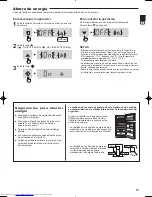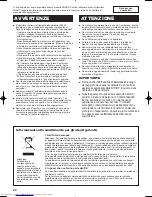
11
CARE AND CLEANING
WARNING
Unplug the refrigerator first to prevent electric shock.
■
Do not splash water directly on the outer cabinet or
■
the interior . This may lead to rusting and deterioration
of the electrical insulation .
IMPORTANT
To prevent cracking on inside surfaces and plastic
components, follow these tips .
Wipe any food oils adhered to plastic components.
•
Some household chemicals may cause damage, so use
•
only diluted washing-up liquid (soapy water).
If undiluted detergent is used or soapy water is not wiped
•
off thoroughly, cracking of plastic parts can result.
1
Remove the accessories e.g. shelves from the cabinet
and door. Wash them in warm soapy dishwashing water;
rinse in clean water and dry. (Only fruit and vegetable
shelf is not removable)
2
Clean the inside with a cloth soaked in warm soapy
dishwashing water. Then, use cold water to wipe off
soapy water.
3
Wipe the exterior with a soft cloth each time it is soiled.
4
Clean the Magnetic door seal with a toothbrush and
warm soapy dishwashing water.
5
Wipe the touch control panel with the dry cloth.
NOTE
To prevent damage to your refrigerator, do not use heavy
•
duty cleansers or solvents (lacquer, paint, polishing powder,
benzine, boiled water, etc.).
If the power supply is disconnected, please wait for at least 5
•
minutes before re-connecting power.
The glass shelves weigh approximately 3 kg each. Hold firmly
•
when removing from the cabinet or carrying.
Do not drop objects inside the refrigerator or strike the inner
•
wall. This may cause the inner surface to crack.
Defrosting
Defrosting is fully automatic due to a unique energy saving
system.
When the compartment light is blown
Contact the service agent approved by SHARP to request a
replacement compartment light. The compartment light is not
to be removed other than by qualified service personnel.
Switching off your refrigerator
If you switch your refrigerator off when you are going away
for an extended period, remove all food, clean the interior
thoroughly. Remove the power cord plug from the power
socket and leave all doors open.
STORING FOOD
IN
OUT
Refrigeration reduces the rate of food spoilage.
To maximize the shelf life of perishable food products,
ensure that the food is of the freshest possible quality.
The following is a general guide to help promote longer food
storage.
Fruit / Vegetables
To minimize moisture loss, fruit and vegetables should be
loosely enclosed in a plastic material e.g. wrap, bags (do not
seal) and place in the vegetable crisper.
Dairy Products & Eggs
Most dairy products have a use by date on the outer
•
packaging which informs the recommended temperature
and shelf life of the product.
Eggs should be stored in the Egg holder.
•
Meats / Fish / Poultry
Place on a plate or dish and cover with paper or plastic
•
wrap.
For larger cuts of meat, fish, or poultry, place to the rear of
•
the shelves.
Ensure all cooked food is wrapped securely or placed in an
•
airtight container.
NOTE
Evenly place the food on the
•
shelves to allow the cooling air
to circulate efficiently.
Hot foods should be cooled
•
before storing. Storing hot foods
increases the temperature in the
unit and increases the risk of
food spoilage.
Do not block the outlet and
•
inlet of the cool air circulating
circuit with foods or containers;
otherwise the foods will not be
evenly cooled throughout the
refrigerator.
Keep the door securely closed.
•
Do not place food directly in front of cold air
outlet. This may lead to the food freezing.
For best freezing
Quality of foods should be fresh.
•
Freeze small quantities of food at a time to freeze them
•
quickly.
Food should be properly sealed, sealed tightly or covered.
•
Evenly place the food in the freezer.
•
Label bags or containers to keep an inventory of freezing
•
food.
(B504)-W.indb 11
2013/11/01 12:26:24












































